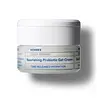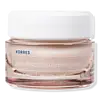What's inside
What's inside
 Key Ingredients
Key Ingredients

 Benefits
Benefits

 Concerns
Concerns

 Ingredients Side-by-side
Ingredients Side-by-side

Water
Skin ConditioningPropanediol
SolventPropylheptyl Caprylate
EmollientAmmonium Acryloyldimethyltaurate/Vp Copolymer
Potassium Cetyl Phosphate
EmulsifyingC13-15 Alkane
SolventCoco-Caprylate
EmollientAloe Barbadensis Leaf Juice Powder
Skin ConditioningAlgin
MaskingAlpha-Glucan Oligosaccharide
CleansingAscorbic Acid
AntioxidantBisabolol
MaskingCaprylyl Glycol
EmollientChamomilla Recutita Flower Extract
MaskingDisodium Phosphate
BufferingGlycerin
HumectantGlyceryl Polyacrylate
Helianthus Annuus Seed Oil
EmollientHydrolyzed Sodium Hyaluronate
Skin ConditioningLactic Acid
BufferingLactobacillus
Skin ConditioningLauroyl Lysine
Skin ConditioningLonicera Caprifolium Flower Extract
PerfumingLonicera Japonica Flower Extract
Skin ConditioningMaltodextrin
AbsorbentMenthyl Lactate
MaskingPanthenol
Skin ConditioningParfum
MaskingPentylene Glycol
Skin ConditioningPolyglyceryl-3 Diisostearate
EmulsifyingPolymnia Sonchifolia Root Juice
Skin ConditioningPotassium Phosphate
BufferingPullulan
Salicylic Acid
MaskingSalvia Hispanica Seed Oil
MoisturisingSerine
MaskingSodium Carboxymethyl Beta-Glucan
CleansingSodium Hyaluronate
HumectantTetrasodium Glutamate Diacetate
Tocopheryl Acetate
AntioxidantTrehalose
HumectantUrea
BufferingXanthan Gum
EmulsifyingYogurt Powder
Zingiber Officinale Root Extract
MaskingBenzyl Alcohol
PerfumingPhenoxyethanol
PreservativeSorbic Acid
PreservativeWater, Propanediol, Propylheptyl Caprylate, Ammonium Acryloyldimethyltaurate/Vp Copolymer, Potassium Cetyl Phosphate, C13-15 Alkane, Coco-Caprylate, Aloe Barbadensis Leaf Juice Powder, Algin, Alpha-Glucan Oligosaccharide, Ascorbic Acid, Bisabolol, Caprylyl Glycol, Chamomilla Recutita Flower Extract, Disodium Phosphate, Glycerin, Glyceryl Polyacrylate, Helianthus Annuus Seed Oil, Hydrolyzed Sodium Hyaluronate, Lactic Acid, Lactobacillus, Lauroyl Lysine, Lonicera Caprifolium Flower Extract, Lonicera Japonica Flower Extract, Maltodextrin, Menthyl Lactate, Panthenol, Parfum, Pentylene Glycol, Polyglyceryl-3 Diisostearate, Polymnia Sonchifolia Root Juice, Potassium Phosphate, Pullulan, Salicylic Acid, Salvia Hispanica Seed Oil, Serine, Sodium Carboxymethyl Beta-Glucan, Sodium Hyaluronate, Tetrasodium Glutamate Diacetate, Tocopheryl Acetate, Trehalose, Urea, Xanthan Gum, Yogurt Powder, Zingiber Officinale Root Extract, Benzyl Alcohol, Phenoxyethanol, Sorbic Acid
Water
Skin ConditioningGlycerin
HumectantGlyceryl Stearate Citrate
EmollientDicaprylyl Carbonate
EmollientTriheptanoin
Skin ConditioningAlcohol Denat.
AntimicrobialBehenyl Alcohol
EmollientGlyceryl Stearate
EmollientAloe Barbadensis Leaf Juice
Skin ConditioningIsodecyl Neopentanoate
EmollientSimmondsia Chinensis Seed Oil
EmollientCera Alba
EmollientLecithin
EmollientImperata Cylindrica Root Extract
Skin ConditioningAcacia Decurrens/Jojoba/Sunflower Seed Wax Polyglyceryl-3 Esters
EmollientRosa Canina Fruit Oil
EmollientAcrylates/C10-30 Alkyl Acrylate Crosspolymer
Emulsion StabilisingAscorbyl Tetraisopalmitate
AntioxidantCaprylyl Glycol
EmollientCarbomer
Emulsion StabilisingCetearyl Alcohol
EmollientCitric Acid
BufferingDistarch Phosphate
AbsorbentGalactoarabinan
Glycine Soja Oil
EmollientGlycine Soja Sterols
EmollientHelianthus Annuus Seed Oil
EmollientHydrolyzed Sodium Hyaluronate
Skin ConditioningHydroxyethyl Acrylate/Sodium Acryloyldimethyl Taurate Copolymer
Emulsion StabilisingLactic Acid
BufferingParfum
MaskingPhenoxyethanol
PreservativeRosa Canina Fruit Extract
AstringentRosmarinus Officinalis Leaf Extract
AntimicrobialRosmarinus Officinalis Extract
AntimicrobialSodium Benzoate
MaskingSodium Gluceptate
Sodium Hydroxide
BufferingTetrahydrodiferuloylmethane
AntioxidantTocopherol
AntioxidantTocopheryl Acetate
AntioxidantXanthan Gum
EmulsifyingWater, Glycerin, Glyceryl Stearate Citrate, Dicaprylyl Carbonate, Triheptanoin, Alcohol Denat., Behenyl Alcohol, Glyceryl Stearate, Aloe Barbadensis Leaf Juice, Isodecyl Neopentanoate, Simmondsia Chinensis Seed Oil, Cera Alba, Lecithin, Imperata Cylindrica Root Extract, Acacia Decurrens/Jojoba/Sunflower Seed Wax Polyglyceryl-3 Esters, Rosa Canina Fruit Oil, Acrylates/C10-30 Alkyl Acrylate Crosspolymer, Ascorbyl Tetraisopalmitate, Caprylyl Glycol, Carbomer, Cetearyl Alcohol, Citric Acid, Distarch Phosphate, Galactoarabinan, Glycine Soja Oil, Glycine Soja Sterols, Helianthus Annuus Seed Oil, Hydrolyzed Sodium Hyaluronate, Hydroxyethyl Acrylate/Sodium Acryloyldimethyl Taurate Copolymer, Lactic Acid, Parfum, Phenoxyethanol, Rosa Canina Fruit Extract, Rosmarinus Officinalis Leaf Extract, Rosmarinus Officinalis Extract, Sodium Benzoate, Sodium Gluceptate, Sodium Hydroxide, Tetrahydrodiferuloylmethane, Tocopherol, Tocopheryl Acetate, Xanthan Gum
 Reviews
Reviews

Ingredients Explained
These ingredients are found in both products.
Ingredients higher up in an ingredient list are typically present in a larger amount.
Caprylyl Glycol is a humectant and emollient, meaning it attracts and preserves moisture.
It is a common ingredient in many products, especially those designed to hydrate skin. The primary benefits are retaining moisture, skin softening, and promoting a healthy skin barrier.
Though Caprylyl Glycol is an alcohol derived from fatty acids, it is not the kind that can dry out skin.
This ingredient is also used as a preservative to extend the life of products. It has slight antimicrobial properties.
Learn more about Caprylyl GlycolGlycerin is already naturally found in your skin. It helps moisturize and protect your skin.
A study from 2016 found glycerin to be more effective as a humectant than AHAs and hyaluronic acid.
As a humectant, it helps the skin stay hydrated by pulling moisture to your skin. The low molecular weight of glycerin allows it to pull moisture into the deeper layers of your skin.
Hydrated skin improves your skin barrier; Your skin barrier helps protect against irritants and bacteria.
Glycerin has also been found to have antimicrobial and antiviral properties. Due to these properties, glycerin is often used in wound and burn treatments.
In cosmetics, glycerin is usually derived from plants such as soybean or palm. However, it can also be sourced from animals, such as tallow or animal fat.
This ingredient is organic, colorless, odorless, and non-toxic.
Glycerin is the name for this ingredient in American English. British English uses Glycerol/Glycerine.
Learn more about GlycerinHelianthus Annuus Seed Oil is the oil derived from the seeds of a Sunflower. Sunflower seed oil is non-fragrant. It is an emollient, meaning it helps to soften the skin.
Sunflower seed oil contains many fatty acids. The fatty acids found in sunflower seeds include (from highest amount to least): linoleic acid, myristic acid, palmitic acid, stearic acid, arachidic acid, oleic acid, and linolenic acid.
These fatty acids help the skin create ceramides. Ceramides play a role in repairing the skin barrier.
Helianthus Annuus Seed Oil helps moisturize the skin. This in turn helps the skin look more rejuvenated and smoother.
Sunflowers are rich in vitamin E.
Historians believe Indigenous cultures of North America domesticated sunflowers before corn. Thus they relied on sunflower oil for a variety of uses. One such use is moisturizing skin and hair.
Sunflower seed oil may not be fungal acne safe. We recommend speaking with a professional if you have any concerns.
Learn more about Helianthus Annuus Seed OilThis ingredient is created by putting sodium hyaluronate through hydrolysis.
You might know this as 'mini' or 'ultra low-molecular weight' hyaluronic acid. The small molecule size means it is able to travel deeper in the skin.
According to studies, low molecular-weight hyaluronic acid can:
One study from 2011 found ultra-low weight HA to show pro-inflammatory properties. Another study from 2022 found it to downregulate UV-B induced inflammation.
Hydrolysis is a process of changing a molecule using water or enzymes.
This ingredient is water-soluble.
Learn more about Hydrolyzed Sodium HyaluronateLactic Acid is another well-loved alpha hydroxy acid (AHA). It is gentler than glycolic acid but still highly effective.
Its main role is to exfoliate the surface of the skin by loosening the “glue” that holds dead skin cells together. Shedding those old cells leads to smoother, softer, and more even-toned skin.
Because lactic acid molecules are larger than glycolic acid, they don’t penetrate as deeply. This means they’re less likely to sting or irritate, making it a great choice for beginners or those with sensitive skin.
Like glycolic acid, it can:
Lactic acid also acts as a humectant (like hyaluronic acid). It can draw water into the skin to improve hydration and also plays a role in the skin's natural moisturizing factor (NMF) in the form of sodium lactate.
Studies show it can boost ceramide production to strengthen the skin barrier and even help balance the skin’s microbiome.
To get results, choose products with a pH between 3-4.
Lower strengths (5-12%) focus on surface exfoliation; higher strengths (12% and up) can reach deeper in the dermis (deeper, supportive layer) to improve skin texture and firmness over time.
Though it was originally derived from milk, most modern lactic acid used in skincare is vegan. It is made through non-dairy fermentation to create a bio-identical and stable form suitable for all formulations.
When lactic acid shows up near the end of an ingredient list, it usually means the brand added just a tiny amount to adjust the product’s pH.
Legend has it that Cleopatra used to bathe in sour milk to help reduce wrinkles.
Lactic acid is truly a gentle multitasker: it exfoliates, hydrates, strengthens, and brightens. It's a great ingredient for giving your skin a smooth, glowing, and healthy look without the harshness of stronger acids.
Read more about some other popular AHA's here:
Learn more about Lactic AcidParfum is a catch-all term for an ingredient or more that is used to give a scent to products.
Also called "fragrance", this ingredient can be a blend of hundreds of chemicals or plant oils. This means every product with "fragrance" or "parfum" in the ingredients list is a different mixture.
For instance, Habanolide is a proprietary trade name for a specific aroma chemical. When used as a fragrance ingredient in cosmetics, most aroma chemicals fall under the broad labeling category of “FRAGRANCE” or “PARFUM” according to EU and US regulations.
The term 'parfum' or 'fragrance' is not regulated in many countries. In many cases, it is up to the brand to define this term.
For instance, many brands choose to label themselves as "fragrance-free" because they are not using synthetic fragrances. However, their products may still contain ingredients such as essential oils that are considered a fragrance by INCI standards.
One example is Calendula flower extract. Calendula is an essential oil that still imparts a scent or 'fragrance'.
Depending on the blend, the ingredients in the mixture can cause allergies and sensitivities on the skin. Some ingredients that are known EU allergens include linalool and citronellol.
Parfum can also be used to mask or cover an unpleasant scent.
The bottom line is: not all fragrances/parfum/ingredients are created equally. If you are worried about fragrances, we recommend taking a closer look at an ingredient. And of course, we always recommend speaking with a professional.
Learn more about ParfumPhenoxyethanol is a preservative that has germicide, antimicrobial, and aromatic properties. Studies show that phenoxyethanol can prevent microbial growth. By itself, it has a scent that is similar to that of a rose.
It's often used in formulations along with Caprylyl Glycol to preserve the shelf life of products.
Tocopheryl Acetate is AKA Vitamin E. It is an antioxidant and protects your skin from free radicals. Free radicals damage the skin by breaking down collagen.
One study found using Tocopheryl Acetate with Vitamin C decreased the number of sunburned cells.
Tocopheryl Acetate is commonly found in both skincare and dietary supplements.
Learn more about Tocopheryl AcetateWater. It's the most common cosmetic ingredient of all. You'll usually see it at the top of ingredient lists, meaning that it makes up the largest part of the product.
So why is it so popular? Water most often acts as a solvent - this means that it helps dissolve other ingredients into the formulation.
You'll also recognize water as that liquid we all need to stay alive. If you see this, drink a glass of water. Stay hydrated!
Learn more about WaterXanthan gum is used as a stabilizer and thickener within cosmetic products. It helps give products a sticky, thick feeling - preventing them from being too runny.
On the technical side of things, xanthan gum is a polysaccharide - a combination consisting of multiple sugar molecules bonded together.
Xanthan gum is a pretty common and great ingredient. It is a natural, non-toxic, non-irritating ingredient that is also commonly used in food products.
Learn more about Xanthan Gum